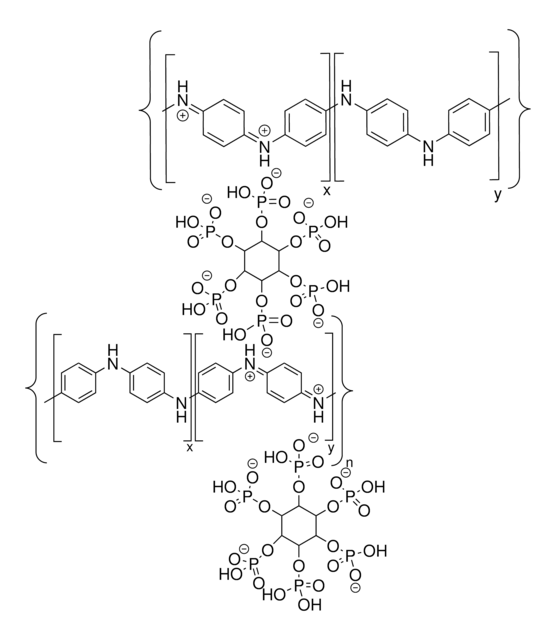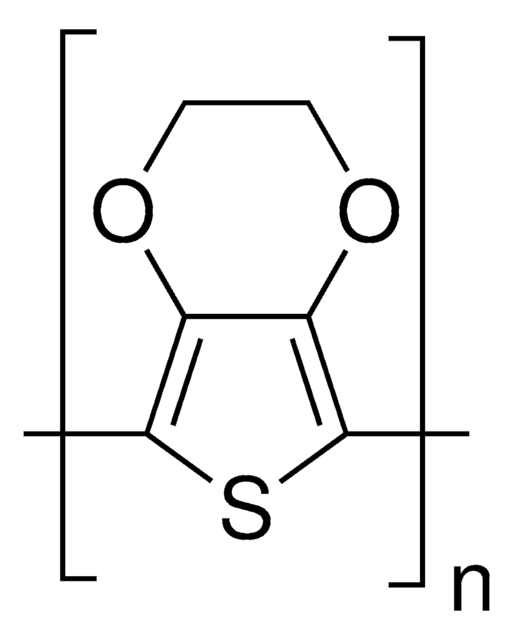576379
Polyaniline (emeraldine base)
average Mw ~100,000
Synonym(s):
Emeraldine base polyaniline
Sign Into View Organizational & Contract Pricing
All Photos(1)
About This Item
Recommended Products
mol wt
average Mw ~100,000
Quality Level
conductivity
1 × 10-9 S/cm (pressed pellet, ASTM F8)
solubility
m-cresol: soluble
DMAC: soluble
DMF: soluble
DMSO: soluble
NMP: soluble
λmax
324 nm
InChI
1S/C3H4BrN3.ClH/c1-2-3(4)6-7-5-2;/h1H3,(H,5,6,7);1H
InChI key
LYCWKZFKTMHXQA-UHFFFAOYSA-N
Looking for similar products? Visit Product Comparison Guide
Related Categories
General description
Polyaniline (PAni) emeraldine salt can be prepared by protonation of PAni emeraldine base (PAni-EB). PAni-EB forms at pH>7. Its mechanism against corrosive agents has been explained in a study.
Polyaniline (emeraldine base) (PANI-EB) is an intrinsically conducting polymer (ICP) that can be formed by oxidative polymerization of aniline. Emeraldine base contains oxidized diimine and reduced diamine. PANI can be modified into the conjugating emeraldine base form by p-type doping with protonic acid.
Application
PANI-EB can form a nanocomposite with multi-walled carbon nanotubes (MWCNTs) that can be used to functionalize glassy carbon electrodes for the electro-sensitive detection of cadmium (Cd(II)) and lead (Pb(II)). Carbon nanofibers may be reinforced on PANI-EB to yield a specific capacitance of 95 F/g and a 92% retention over 3000 cycles as observed in supercapacitor applications. It may be used with heptamethyleneimine as an inhibitor to form stable fuel cell membranes.
Features and Benefits
Undoped form of conducting polymer (non-conductive).
Storage Class Code
11 - Combustible Solids
WGK
WGK 3
Flash Point(F)
Not applicable
Flash Point(C)
Not applicable
Personal Protective Equipment
dust mask type N95 (US), Eyeshields, Gloves
Choose from one of the most recent versions:
Already Own This Product?
Find documentation for the products that you have recently purchased in the Document Library.
Customers Also Viewed
Engineering conformal nanoporous polyaniline via oxidative chemical vapor deposition and its potential application in supercapacitors
Li X, et al.
Chemical Engineering Science, 220, 267-275 (2018)
Polyanilines: a novel class of conducting polymers
MacDiarmid AG and Epstein AJ
Faraday Discussions of the Chemical Society, 88, 317-332 (1989)
Synthesis and characterization of polyaniline membranes with-secondary amine additive containing N, N?-dimethyl propylene urea for fuel cell application
Kumar A, et al.
International Journal of Hydrogen Energy, 220, 267-275 (2018)
Study of epoxy and alkyd coatings modified with emeraldine base form of polyaniline.
Armelin E, et al.
Progress in Organic Coatings, 58, 316-322 (2007)
Our team of scientists has experience in all areas of research including Life Science, Material Science, Chemical Synthesis, Chromatography, Analytical and many others.
Contact Technical Service




